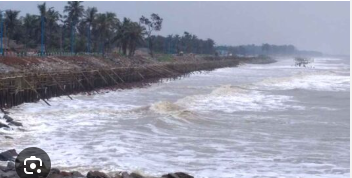Context:
Recently, High Sea waves which are also known as swell waves (is called swell surge or Kallakkadal), have flooded numerous houses in the Kerala’s coastal areas.
More on News
Hundreds of residences in various coastal zones of Kerala have experienced flooding.
- This flooding caused by the swell waves is called swell surge or Kallakkadal in Malayalam.
- Alappuzha, Kollam, and Thiruvananthapuram districts are among the hardest-hit areas.
Indian National Centre for Ocean Information Services (INCOIS) in 2020 launched an early warning system called the Swell Surge Forecast System.
- INCOIS usually gives a 7-day advanced warning.
- It has alerted people in coastal areas vulnerable to sea erosion to take precautionary steps and ensure the safety of fishing vessels.
What is Kallakkadal?
- It is a geographical phenomenon which causes flooding through high waves, during the pre-monsoon season (April-May) along India’s south-west coast.
- The expression ‘Kallakkadal,’ coined by local fishermen is a fusion of two Malayalam words which is ‘Kallan’ denoting thief, and ‘Kadal,‘representing sea. When Comined together, the words ‘Kallakkadal’ signify ocean that arrives as a thief.
- The term was formally approved by UNESCO in 2012.
Factors behind Kallakkadal
- Kallakkadal is caused by waves generated by ocean swells hence known as swell surge.
- Unlike local winds ocean swells originate from distant storms such as hurricanes or prolonged periods of intense gale winds.
- These storms transfer significant energy from the air to the water leading to the formation of exceptionally high waves.
- These waves can traverse vast distances from the storm’s center until they reach the coastline.
- Typically, Kallakkadal results from strong winds in the southern Indian Ocean where ocean swells are created and these waves then propagate northward reaching the coast within two to three days.
- It occurs spontaneously without any precursor or local wind activity.
How Kallakkadal different from tsunami?
- Kallakkadal is caused by waves generated by ocean swells or hurricanes.
- On the other hand, tsunami which is a series of enormous waves due to seismic activity like earthquakes, underwater landslides or volcanic eruptions.

